2014 Annunciation Bathing Suit
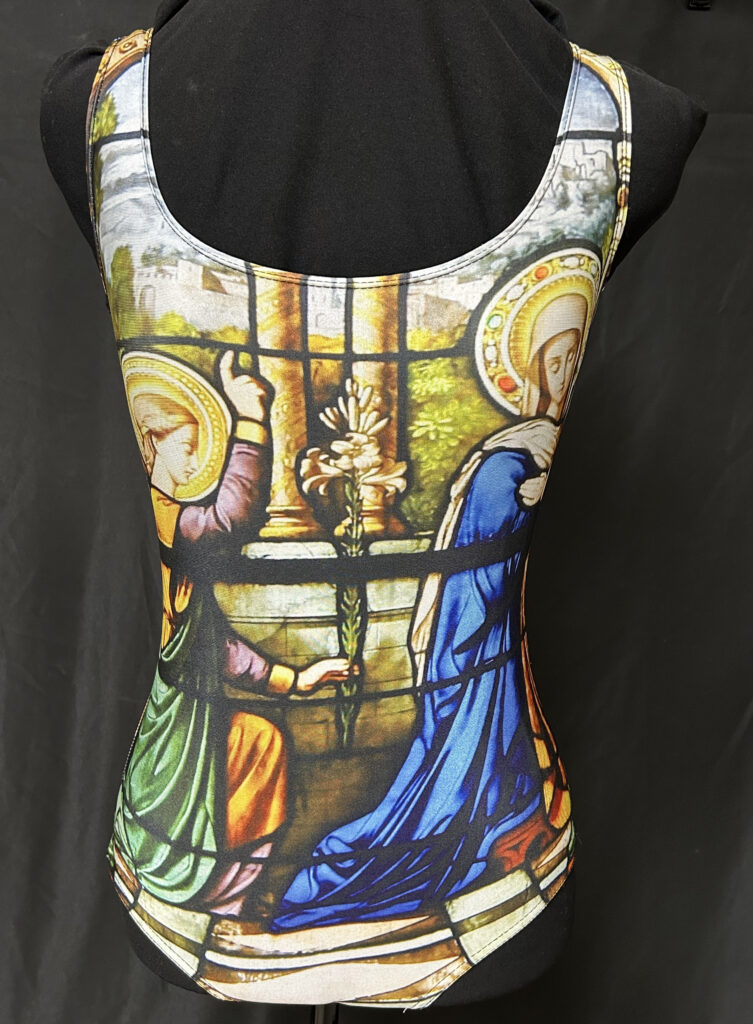
Religion: Christianity
Time Period: 2010s
Type Of Garment: Bathing Suit
Tags: Annunciation, Bathing Suit, Claudius Lavergne, Everyday, Fast Fashion, Gabriel, Mary, Stained Glass, United States
The Object:
This one-piece bathing suit features a stained-glass print of the Annunciation scene in which the angel Gabriel appears to Mary (see Figure 1). According to Luke 1:26-38, Gabriel informs Mary that she has found favor with God and will conceive a child, to be called Jesus, through the power of the Holy Spirit. In Christian history, the Annunciation simultaneously emphasizes Mary’s special status and the coming of the messiah. In this artistic depiction, the winged and haloed Gabriel wears deep green, copper, and brown robes while kneeling and presenting a white lily to Mary. Adorned in her traditional blue with a halo and a white veil, Mary’s downward gaze and crossed arms highlight her humble and reflective response to Gabriel’s good news.

In many ways this stained-glass rendering reflects dominant themes in art of the Annunciation. For example, Gabriel’s profile position and Mary’s forward-facing pose and their appearance in a porch-like space resemble earlier paintings by renowned artists, including Filippo Lippi, Leonardo da Vinci, Jan van Eyck, and Fra Angelico. The garden seen through the arches symbolizes Mary’s virginity. In addition, many artistic portrayals of this event include the white lily, a symbol of Mary’s virginity and spiritual purity, but also, according to St. Bernard of Clairvaux, representative of Jesus (Fitzwilliam Museum). In many ways the beautiful scene is unremarkable as it adheres to common artistic norms and Christian symbols.
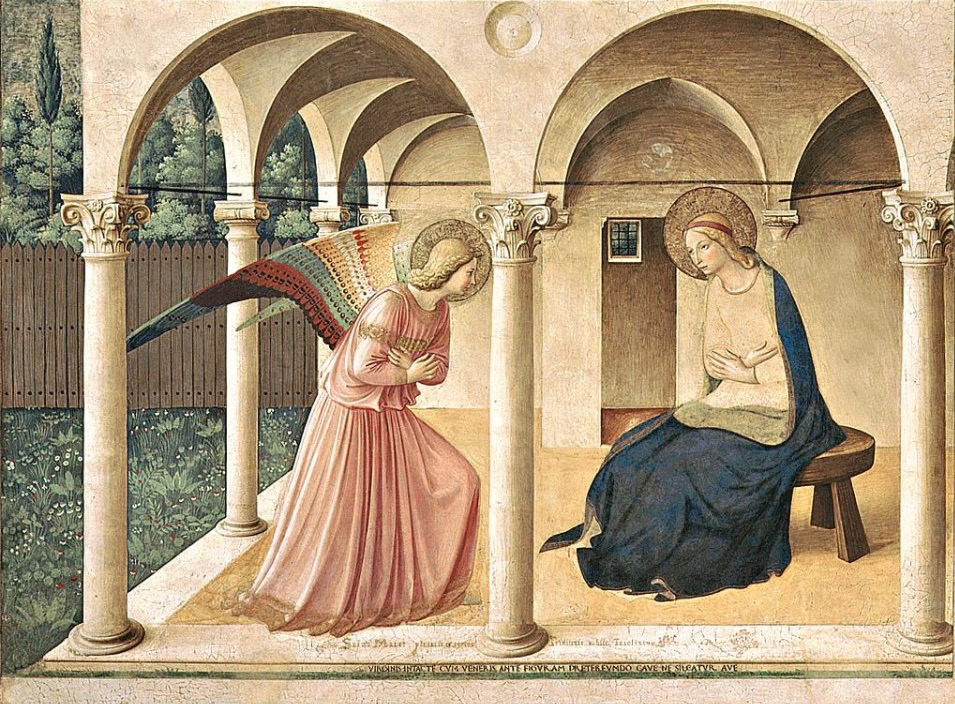
However, its appearance on a twenty-first century bathing suit introduces an unexpected element. In American Christianity, women’s bathing suits have often caused controversy and concern. Ministers debated what constituted modest swimwear for women, beach towns created laws restricting where bathing suits could be worn, and widespread protests accompanied the rising popularity of the bikini in the 1960s. Thus, the placement of the Annunciation, an event that highlights spiritual purity and virginity, on a sexualized article of clothing deliberately plays on the perceived antagonism between Christianity and fashion to gain attention, notoriety, and sales. This was certainly the case in 2022 when influencer Addison Rae wore Praying’s “Holy Trinity” bikini (see Figure 3), which inspired some backlash, but also inevitably led more people to Praying’s products (Singh-Kurtz, 2022).
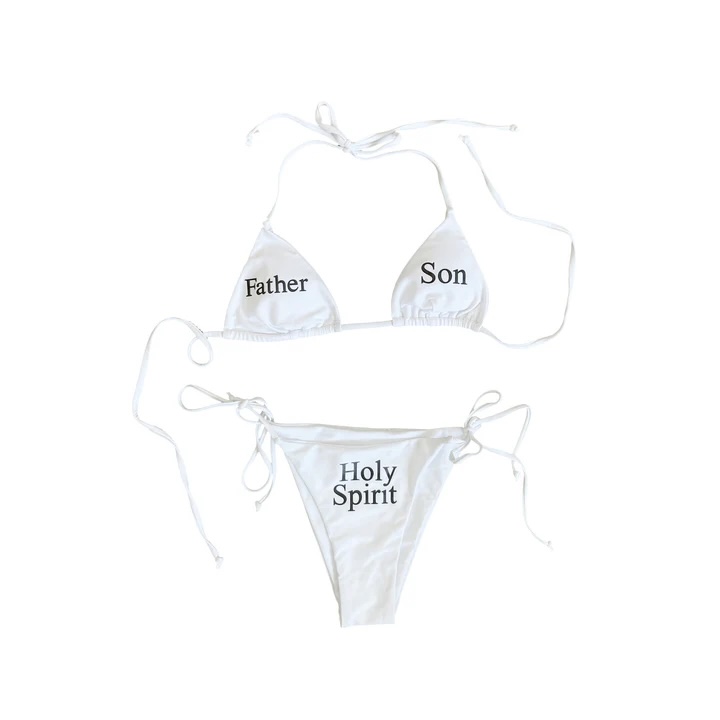
While more demure than Praying’s bikini, the placement of the stained-glass Annunciation image on this one-piece swimsuit does raise some questions. For example, the halos of Gabriel and Mary highlight the potential wearer’s breasts. Is this simply the result of placing the scene on the suit or was it a more intentional design choice intended to transgress assumed religious norms and thereby gain attention? Similarly, the placement of the stained-glass dove on the back of the bathing suit emphasizes the potential wearer’s backside (see Figure 4). Was this done intentionally or accidentally? While this Annunciation bathing suit did not cause a controversy, it does raise important questions about the relationship between Christianity and fashion and the use of Christian imagery in fashion.
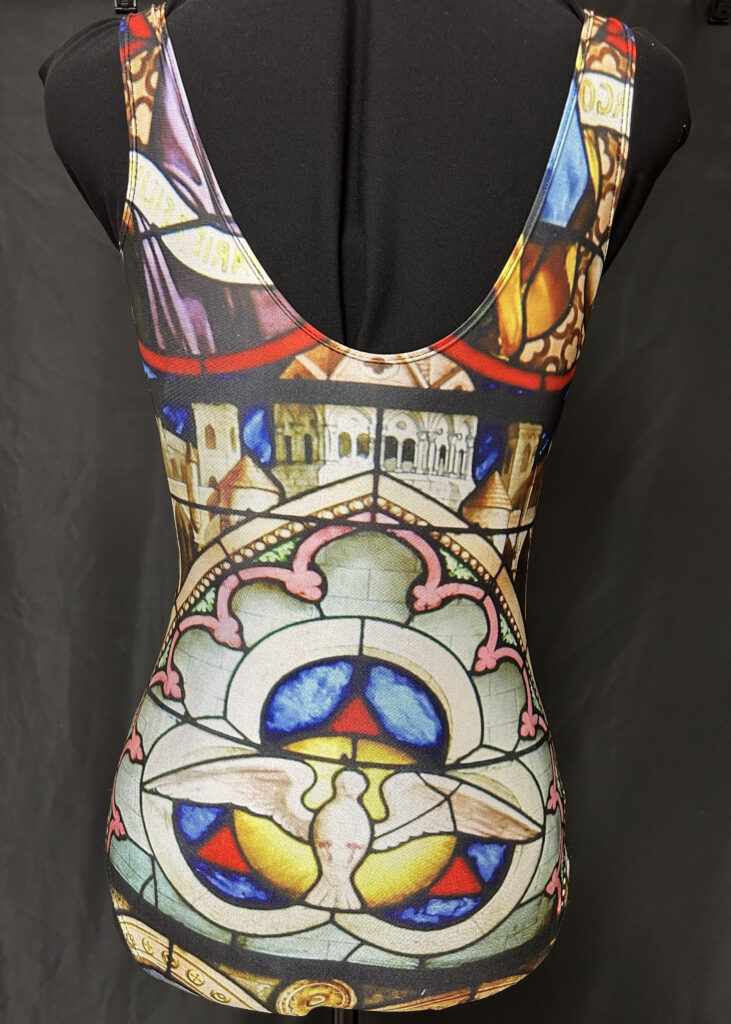
The Context and Creator:
Numerous fashion designers, including Gianni Versace, Dolce & Gabbana, and Jean Paul Gaultier, have been inspired by Christian history and symbols. Further, collections with Christian themes and elements often receive a lot of publicity—positive and negative (Neal 2019). In addition, since Comme des Garçons founder Rei Kawakubo’s Spring 1991 collection, “Ink Dye, Stained Glass,” fashion designs featuring stained glass have become more common. While Kawakubo’s designs faithfully rendered the biblical scenes in stained glass windows from Chartres Cathedral and the Laon Cathedral (Arronson), designers such as Jeremy Scott utilized a stained-glass motif to highlight body shapes and contours in his Fall 2010 Ready-to-Wear collection (Schneier 2010). And in 2013, Karla Špetić’s “Faith” collection gained attention for its inclusion of stained-glass garments, including one with an angel print and two depicting Jesus (see 2013 Sleeveless Crop Top). While exhibiting vastly different aesthetics, the designers’ use of stained glass in each collection prompted audiences to think about Christianity and its role in life, as well as fashion. In many ways, then, the Annunciation bathing suit replicates an existing fashion trend.
Unlike these designer garments that emphasize artistic inspiration and represent a significant monetary investment, the Annunciation bathing suit represents an example of fast fashion— the mass production of high-fashion trends at a low cost. The bathing suit was purchased in 2014 for $15.99 from Amazon by the brand Massa. The suit is no longer for sale and the brand has since disappeared but given the price point and its mimicking of designer trends its fast fashion status seems evident. As fashion writer Anna Battista explains, fashion designers may find Christian themes and symbols inspiring, “but the truth is that copying religious paintings and imagery is copyright free. It is indeed very unlikely to end up in court for copyright infringement if you reproduce in your design a dress donned by a statue of the Virgin Mary” (2013). The bathing suit description—“digital print tight stretch one-piece swimwear Jesus painting”—mistakenly refers to the design as a “painting” and including “Jesus,” which seems to further indicate monetary motives, rather than divine or artistic inspiration. A free design combined with a fashion trend seems like a match made in heaven for fast fashion.
In this case, the reproduction was a stained-glass window from the Basilica of Notre Dame in Geneva, Switzerland. The window (see Figure 5) was part of a series designed by French artist Claudius Lavergne (1815-1887) for the Basilica. Lavergne, originally a painter, became more well known for his richly colored stained-glass windows of biblical scenes. In addition to the Basilica in Geneva, his work appears at the Chapel of Hôpital Lariboisière (Paris), the Basilica of Notre Dame des Victoires (Paris), Cathedral of our Lady of Senlis, the Church of Saint Nizier (Lyon), and numerous others. Historically, stained-glass windows provided illiterate parishioners with a visual text of the Bible that they could “read” (Victoria & Albert Museum). However, stained-glass windows also enhanced worshippers’ sensory and spiritual experiences through their transmission of light, a quality Christians often attribute to God. As one expert noted, “the extension of the illuminated surface, the richness of the palette and its modulations belonged to a symbolism expressive of the divine world. The terrestrial element yielded its place to the ethereal, the luminous, the celestial element” (Dilasser 1999: 86).
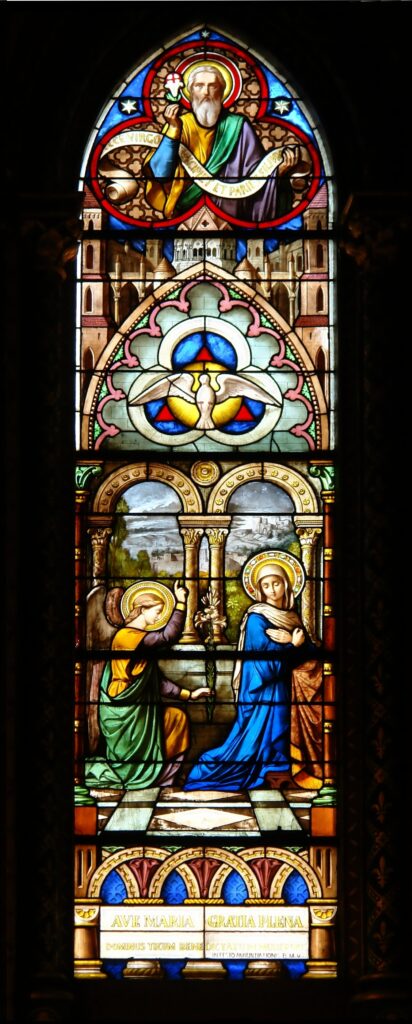
The Reception:
In transferring the Annunciation scene from a stained glass window to a bathing suit, the art loses its ability to transmit light and removed from its religious context, questions about its meaning and purpose arise. It’s likely that Claudius Lavergne would have disapproved of his art being placed on such a garment. In the 1860s, he criticized another artist for “irreligious motives” and for depicting angels as “divine furies,” rather than “messengers of piety and peace” (Professor-Moriarty). It seems probable, then, that the “irreligious” monetary motives of the suit’s creator combined with placing a religious subject on a sexualized article of clothing would offend Lavergne. However, in the twenty-first century American context, where religious affiliation is declining and sacred imagery increasingly circulates in secular spaces, such interpretations have become more fluid and diverse. The Annunciation bathing suit may have scandalized Lavergne, but it offers us a compelling case study of how Christianity and fashion intersect in contemporary culture. Through its transformation of sacred art into swimwear, the suit provides viewers and potential wearers with multiple readings that range from religious critique to spiritual nostalgia to Christian devotion.
Lynn S. Neal, Professor of Religious Studies, Wake Forest University.
28 January 2025
Tags: Annunciation, Bathing Suit, Claudius Lavergne, Everyday, Fast Fashion, Gabriel, Mary, Stained Glass, United States
References:
Arronson, Sarah. n.d. “The Rose Window.” Sarahaaronson.com. Accessed 20 January 2025. Available at: https://www.sarahaaronson.com/blog/unmulwracvqvrrzid47j4m2ptekuik
Battista, Anna. 2013. “Fashioning Religion: How a Fake Search for the Spiritual Became an Unfashionable Trend.” Irenebrination, 29 August. Available at: https://irenebrination.typepad.com/irenebrination_notes_on_a/2013/08/fashioning-religion.html
Dilasser, Maurice. 1999. The Symbols of the Church. Collegeville, MN: The Liturgical Press.
Fitzwilliam Museum. n.d. “The Annunciation.” Accessed 17 January 2025. Available at: https://fitzmuseum.cam.ac.uk/explore-our-collection/highlights/context/sign-and-symbols/the-annunciation
Neal, Lynn S. 2019. Religion in Vogue: Christianity and Fashion in America. New York: New York University Press.
Professor-Moriarty.com. 2009. “Lavergne, Claudius – Paris.” Available at: https://professor-moriarty.com/info/section/stained-glass/designers/france-lavergne-claudius-paris
Schneier, Matthew. 2010. “Jeremy Scott: Fall 2010 Ready-to-Wear.” Vogue.com, 16 February. Available at: https://www.vogue.com/fashion-shows/fall-2010-ready-to-wear/jeremy-scott
Singh-Kurtz, Sangeeta. 2022. “God and Garbage: Talking with the Two Dudes Behind the Niche Internet Brand Praying.” TheCut.com, 12 September. Available at: https://www.thecut.com/2022/09/praying-brand-holy-spirit-bikini.html
Victoria & Albert Museum. n.d. “Sacred Stained Glass.” Accessed 20 January 2025. Available at: https://www.vam.ac.uk/articles/sacred-stained-glass
